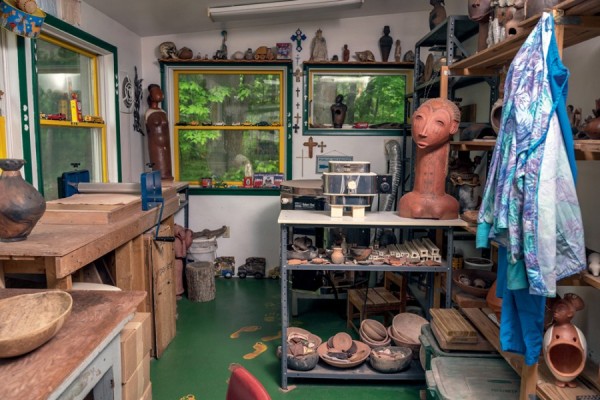
Studio of Babette Wainwright, Madison, Wisconsin, 2022. (Unless otherwise noted, all photography by Dakota Mace.)

Studio of Babette Wainwright, Madison, Wisconsin, 2022.
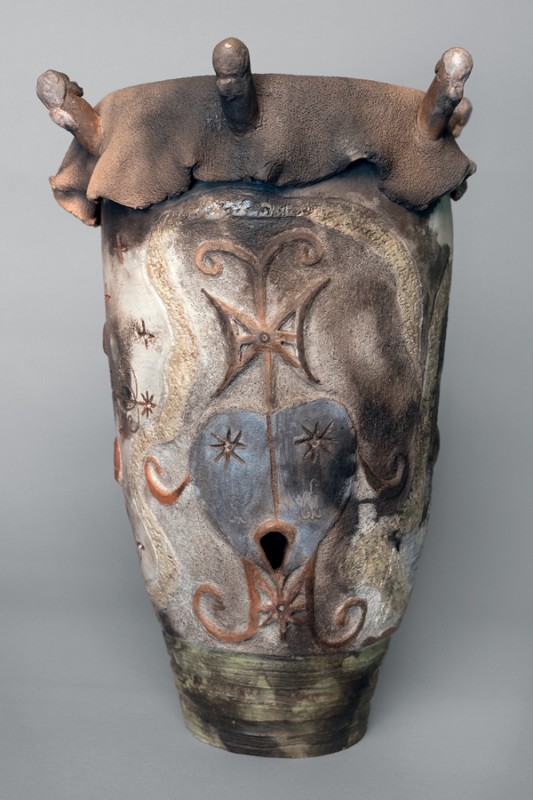
Babette Wainwright, Night Whispers, Madison, Wisconsin, 1999. Commercial clay and pigments. H. 19".
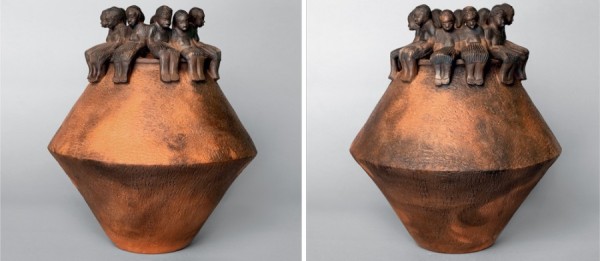
Babette Wainwright, Prayer Circle, Madison, Wisconsin, 2021. Lowfired earthenware and pigments. H. 12".
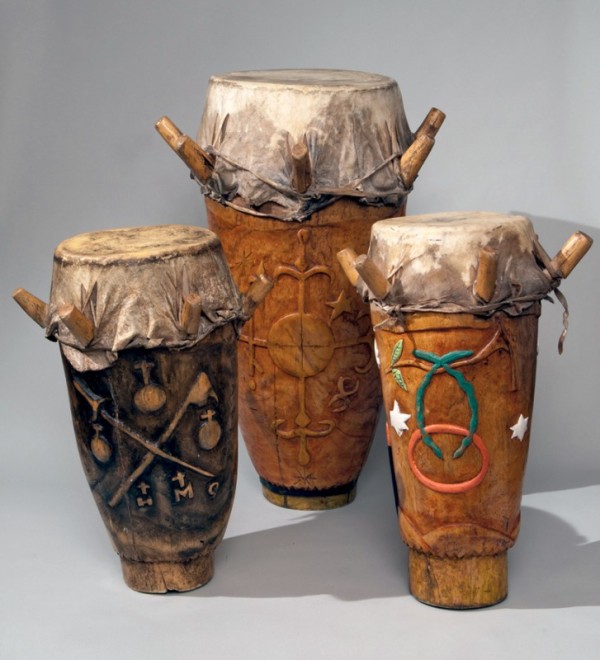
Unidentified Haitian artist, Maman, Segon, and Boula (Vodou drum set) with vèvè, circa 1960. Haitian hardwoods and cowhide. H. of tallest 31 1/2". (Courtesy of Duke University, Sacred Arts of the Black Atlantic.) Dr. J. Lorand Matory, Lawrence Richardson Distinguished Professor of Cultural Anthropology at Duke University, purchased this drum set from a Voudouizan in Boston in 2008.
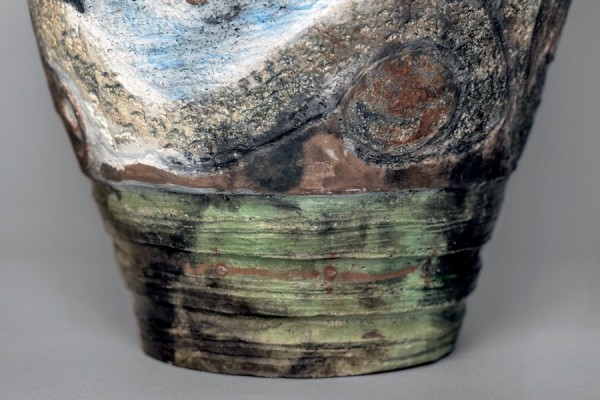
Detail of Night Whispers, illustrated in fig. 3.
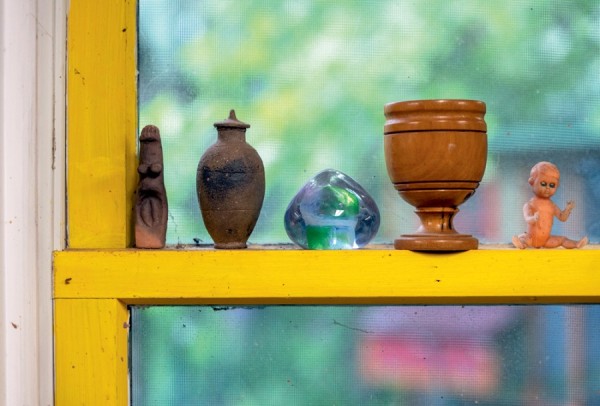
Detail of Babette Wainwright’s studio window with miniature kanari, 2022.
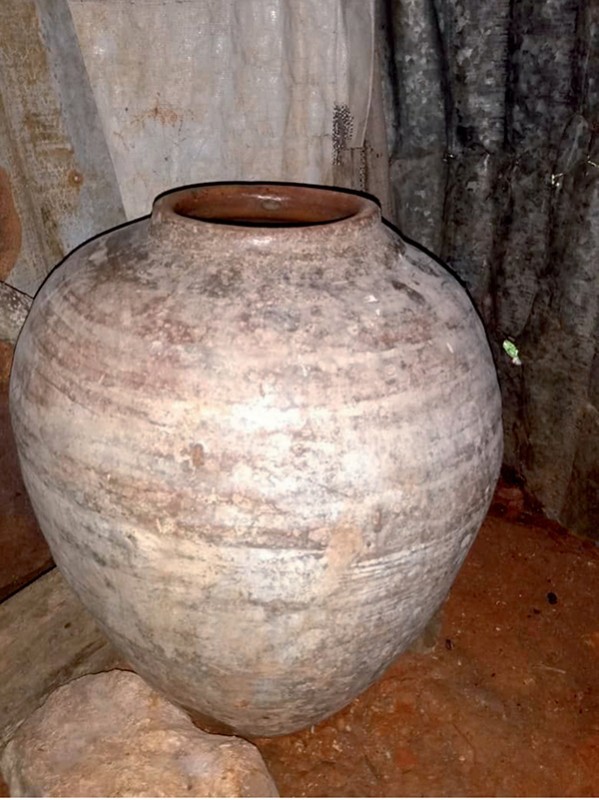
Kanari in the kitchen of the Paul Family Home, 2023, Désormeau neighborhood, Dame-Marie, Haiti. Digital photograph. (Courtesy of Culcoit Paul.)
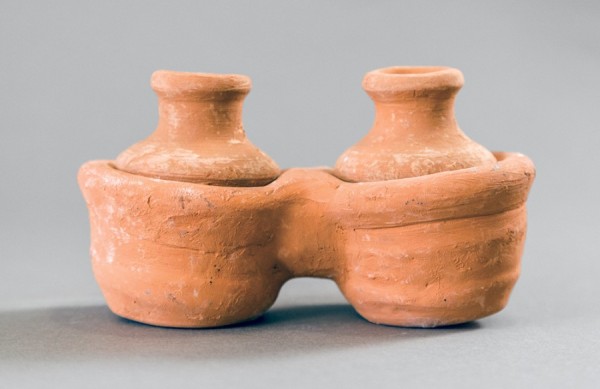
Unidentified Haitian artist, double pot and drink vessels for the Marassa Spirits, 2017. Lowfired earthenware. W. 8". (Courtesy of Duke University, Sacred Arts ofthe Black Atlantic.) Dr. Matory purchased these Marassa pots at Marché Hippolyte in Port-au-Prince, Haiti.
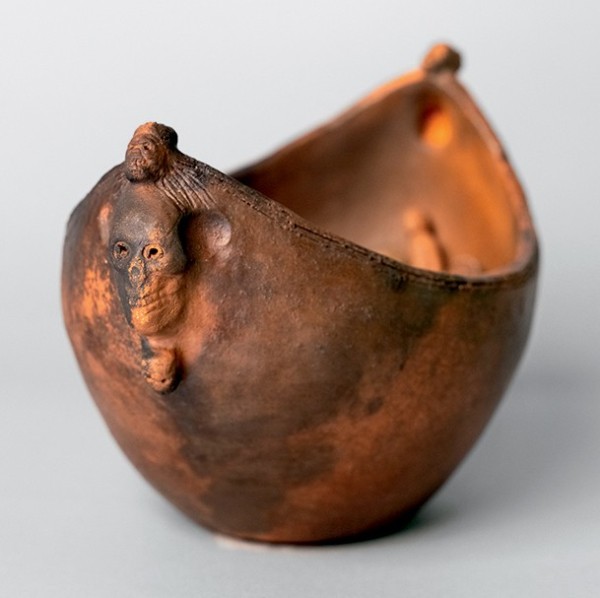
Babette Wainwright, Taino Vessel, Madison, Wisconsin, 2021. Lowfired earthenware. H. 7".
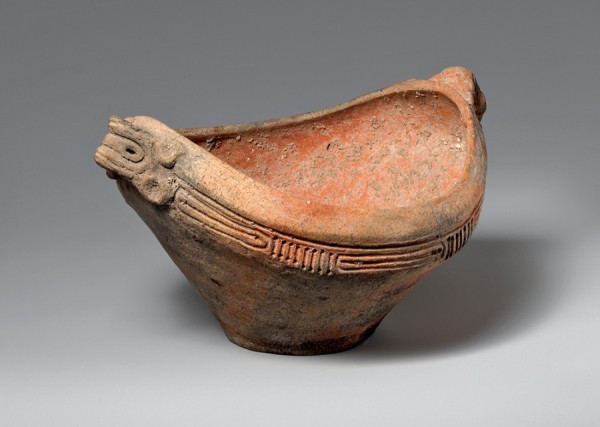
Unidentified Taíno artist, Bowl, thirteenth–fifteenth century. Low-fired earthenware. W. 9". (Metropolitan Museum of Art, Gift of Vincent and Margaret Fay, 1993, 1993.523.2.)
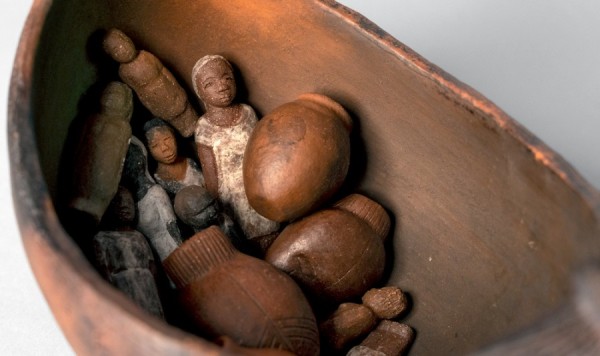
Detail of Taíno Vessel illustrated in fig. 10.
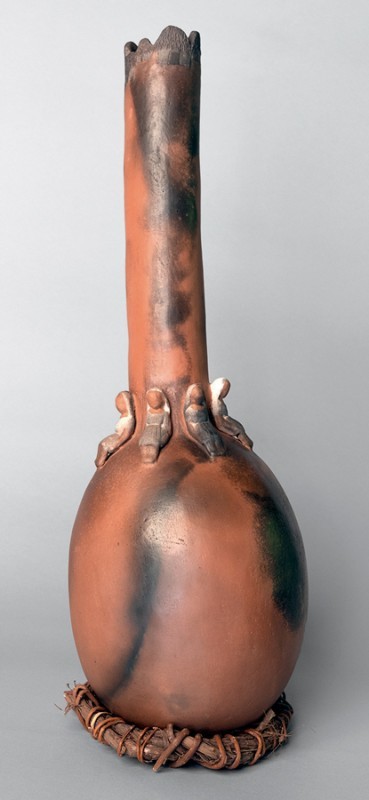
Babette Wainwright, Dreaming of Rising, Madison, Wisconsin, 2006. Low-fired earthenware. H. 22".
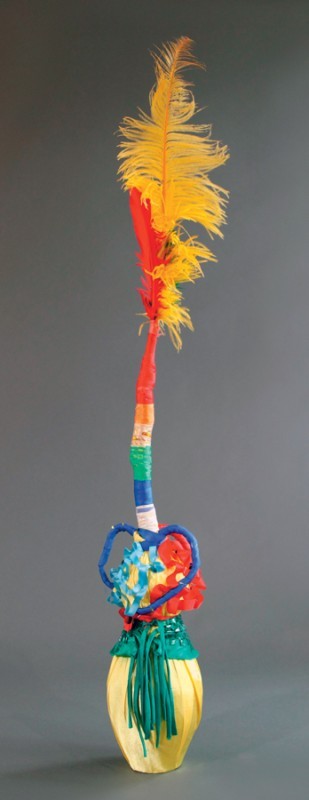
Unidentified Haitian artist, Pakèt Kongo for Papa Loko, 2018, feathers, satin ribbon, and mixed media, 26" x 6". (Photo courtesy of Duke University, Sacred Arts of the Black Atlantic.) Manmi Maude and the other priests of the Sosyete Nago Temple in Jacmel, Haiti, prepared this pakèt kongo for Dr. Matory in a series of ceremonies in 2018.

Kalbas, Babette Wainwright’s Studio, Madison, Wisconsin, 2022.
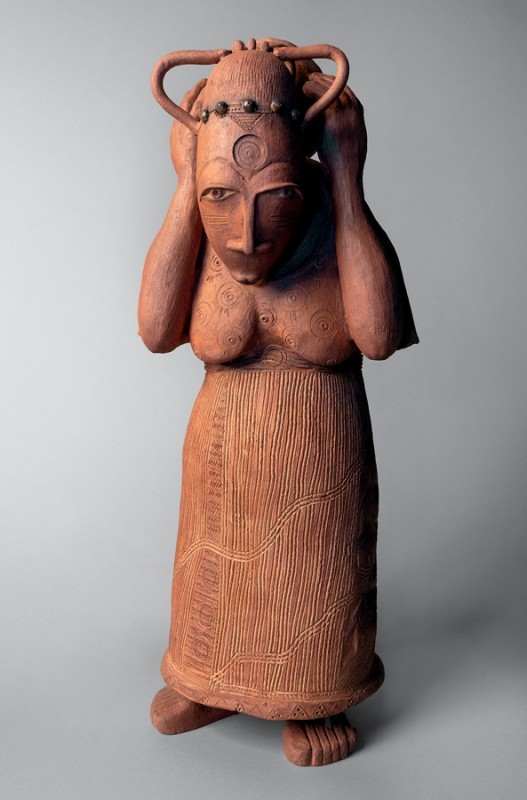
Babette Wainwright, Water Bearer, Madison, Wisconsin, 2008. Low-fired earthenware. H. 24"
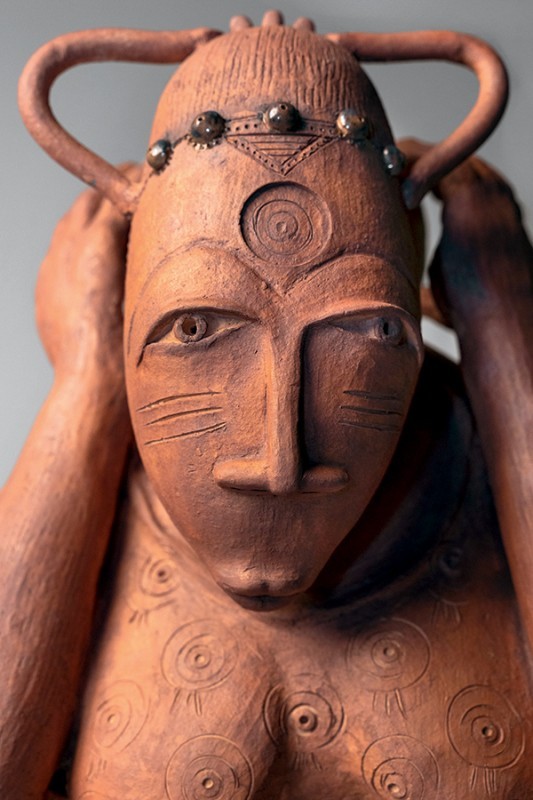
Detail of Water Bearer, illustrated in fig. 16.

Babette Wainwright, Kiln Watcher, Madison, Wisconsin, 2000. Lowfired earthenware. H. 14".
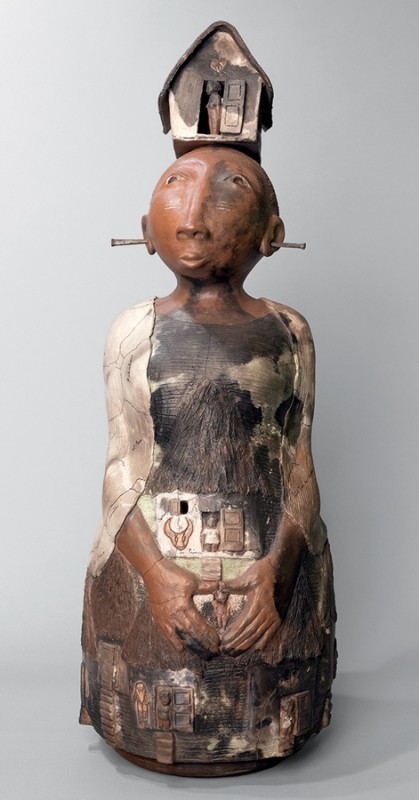
Babette Wainwright, Sel Lakay Ki Kraze, Madison, Wisconsin, 2010. Low-fired earthenware and pigments.H. 28 1/2".

Detail of Sel Lakay Ki Kraze, illustrated in fig. 19.

Babette Wainwright, Potomitan, Madison, Wisconsin, 2002. Low-fired earthenware. H. 75".
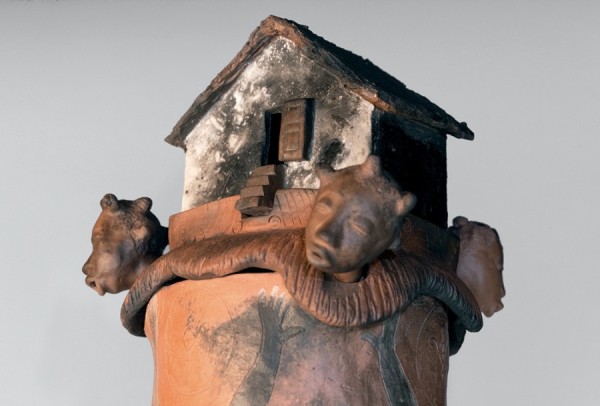
Detail of Potomitan, illustrated in fig. 21.

Babette Wainwright in her studio, Madison, Wisconsin, 2022. (Photo, R. Ruthie Dibble.)
FOR MANY ARTISTS, the studio is a revealing accretion of lifelong inspirations, experimental processes, and future trajectories. This biographical quality is especially true for the artist Babette Wainwright (b. 1952), whose studio at her home in Madison, Wisconsin, is richly layered with memorabilia, artworks, tools, and materials from a decades-long process of exploring her Haitian identity through the medium of clay.
The space is anchored by a wall of handbuilt wooden shelves holding many of Wainwright’s most personally meaningful work. Each earthenware sculpture is intimate and meditative, combining the warm earthenware materiality of utilitarian pots from her childhood in Haiti, the aesthetics of Taíno pottery, and female figures embodying Haitian culture and spirituality (fig. 1). Handmade tools and molds, as well as clay ready to be used, are carefully stacked and arranged around her workbench; large windows lined with keepsakes from her travels back to Haiti and elsewhere frame views of her kiln and garden (fig. 2).
This neat, spare space reflects the values Wainwright absorbed in her childhood from her mother, who would remind the budding artist that the tres cher art supplies imported to Port-au-Prince from France required great care. Wainwright’s studio is still marked by conscientious caretaking of the physical environment, which extends into each artwork she makes and the African diasporic experiences they embody. This maternal ethos is fitting, because Wainwright has always believed that her work in clay is “a family reunion,” a creative calling to conjure familial beings and belonging into the often lonely and uprooted spaces of her diasporic experience. In April 2022 I joined Wainwright in her studio, to explore why clay is her chosen medium, and how the milestone works that live in her studio illuminate her deeply personal and innovative ceramic practice.
The Journey
Wainwright will never sell Night Whispers (fig. 3), a coil-built clay vessel in the tapering shape of a Boula, the smallest of the Rada drums, that sits on a shelf behind her workbench. In its materials, Night Whispers is an outlier dating to the very beginning of Wainwright’s ceramic career when she was an MFA student in ceramics at the University of Wisconsin—it is the last work she made with commercial clay. And yet, because it sets forth the spiritual landscape of the artist’s life, Night Whispers is a “self portrait.” The title nestles us within her intergenerational memory of Haiti and conveys her intentions for the work. As Wainwright explains, “Night whispers is the time in Haiti when the work is done and you gather together on the terrace and you tell stories . . . ghost stories, stories with a moral, and any Haitian, any diaspora person, who carries on the culture, is telling sacred stories of your people, your sense of morality, your sense of history, of your history.”[1] For Wainwright, these stories are “about the passage, leaving one for the other; journeys across geographies and through the changes of life.”
On Night Whispers, the pegs of the Boula take on the form of manbo (Vodou priestesses), identifiable by the white handkerchiefs on their heads. The gathering of manbo figures remains an ongoing theme in Wainwright’s work. In her vessel Prayer Circle (fig. 4), the manbo Rada-drumming calls on ancestral spirits—lwa—for their aid, instruction, and special powers; in Wainwright’s words, “the drum is the storyteller” in Haitian culture. Rada drums are often carved and painted with the vèvè, or religious symbols that also call forth the lwa (fig. 5).[2] On the surface of Wainwright’s drum are the vèvè of the lwa who have shaped her life, most fundamentally Erzulie, embodiment of love and women, an overwhelmingly creative force who often claims gay and queer artists.[3] Wainwright’s Erzulie vèvè is rubbed with blue and red pigments and contains the only opening in Night Whispers. That hole evokes the boundlessness of this lwa’s maternal love: “She’s a heart and she bleeds; she bleeds love, she bleeds sadness, she is the ultimate mother.” Through her paternal grandfather, Alexandre Wainwright, a lawyer and Vodouisant (practitioner of Vodou) who was also her godfather, Wainwright became an initiate of Erzulie minutes after she was baptized in the Catholic faith, when he carried her straight from the church to the ounfò (Vodou temple).
On Night Whispers, the sailboat vèvè of Agwé, the lwa who rules over the sea, and the mast vèvè of Badé, the lwa of wind and “keeper of the four directions,” emerge from a matte background carved in shallow relief and burnished and pigmented. They are enwrapped by the scaly bodies of Ayida and Dumballa, the water serpents that represent life and death, man and woman, and that have followed and protected Wainwright and her ancestors across many journeys. The vèvè float over a green, mountainous landscape that wraps around the base of Night Whispers (fig. 6). The iconography of Night Whispers looks back at the culture and spirituality that shaped Wainwright, her journey into the social and psychological space of becoming a Haitian refugee, and her awakening to ceramics as her chosen medium. This flux in time runs through Wainwright and into her work. As sociologist Sarah Daynes has observed, “Events that produce meaning, in particular when they have not been ‘resolved,’ never stop ‘surviving’; in the case of the African diaspora, the past of slavery still makes sense today, as if the slave ships were still crossing the Atlantic each day, over and over again. Indeed, memory is not a linear phenomenon.”[4] Likewise, Wainwright’s artistic exploration of African diasporic experiences are nonlinear narratives, Night Whispers included: “This whole thing is me, she has stories to tell, she’s telling you stories, all you have to do is listen.”
Beginnings
Babette Wainwright’s explorations of her personal history with clay begins with a small, lidded vessel she made, easily overlooked among her larger sculptural work (fig. 7). Resting on the sunny yellow muntin of the window above her workbench, the object is a miniature kanari, the traditional, coil-built earthenware urns made in Haiti to hold water (fig. 8). If, as the literary theorist Susan Stewart has observed, “the miniature is a world of arrested time,” this small work makes ever present the time of Babette’s childhood in Haiti in the 1950–60s, when earthenware kanari were ubiquitous and a necessary part of Haitian foodways and spirituality.[5] Wainwright and her family lived in a “cute little house in a tamarind grove,” where the kitchen, in keeping with Haitian domestic architecture, was a small, separate structure at the back of the house. There, the family stored their kanari, which was kept full of cool, clear water by the family’s cook. To the young Wainwright, the large storage vessel was enchanting. It “felt ancient and magical because the water that was kept in it was always cool, and you could talk into it and hear your voice echoing back.” Even then, Wainwright sensed a connection between clay vessels and the women of Haiti. The fulsome, echoing vessel felt “like a big woman.”
Wainwright would also encounter kanari and other island-made vessels in Haiti’s Vodou religion. She has noted that in Haiti ceramics are “ritual objects; I didn’t grow up seeing things like that as artwork.” Indeed, as the scholar Roberto Strongman has observed, “Unlike the Western idea of the body as the enclosure of the soul, in Haiti Vodou, the soul is an open vessel that finds metaphoric and aesthetic expression in seemingly utilitarian vessels,” not only the kanari but also the kwi (calbash bowl) and govi (a ceremonial jar or bottle made of red clay).[6] Indeed, the badji in any ounfò, or altar in any Vodou temple, holds a “profusion of pottery” organized in tiers and clusters, and ceramic vessels are often at the heart of Vodou ceremonies, including offerings to Marassa Jumeaux, the divine twins of Vodou, who are offered manje marassa, or twins’ food, from conjoined coiled pots symbolizing their twinned identities (fig. 9).[7] This crucial metaphor for the soul binds the Haitian diaspora to their Dahomean ancestors in West Africa, a history explored in relation to Wainwright’s work by Kyrah Malika Daniels, who has rightly identified the artist as “a creator with deep spiritual knowledge about the power of mystic pots.”[8]
Although Haitian-made earthenware was everywhere in the foodways and spirituality of Wainwright’s childhood, and she played at shaping earth into vessels as a small child, it was excluded from the dominantly francophone arts education. Instead, art instruction was dominated by drawing and painting, and Wainwright excelled in them. As she recalls, “I have never not made art,” and some of her earliest memories come from developing and colorizing portraits for her father in his photography studio in Port-au-Prince. Her family, and especially her mother, supported her artistic talents. She was enrolled in formal art classes, where her teachers promulgated the aesthetics and subject matter of the Haitian “Renaissance” that began in the 1940s with the arrival of the American artist and English teacher Dewitt Peters, the founding of the Centre d’Art in 1944, and the popularization of Haitian artists such as Hector Hyppolite and Philomé Obin in the ensuing years.[9] Wainwright has vivid memories of secluding herself with paints and canvas in the refined silence of le salon—the formal parlor—in her family home: “surrounded by wooden floors, and glass all around, I would paint and listen to music and read and draw.” In the cosmopolitan art scene of Haiti’s capital, Wainwright achieved significant success and exhibited at the prestigious Centre d’Art when she was still a teenager.
At the same time, Wainwright strained against the colonialist dynamics endemic to mid-twentieth-century Haitian art. Her teachers, she remembers, “would give me an art book and I would flip through and look at the masters; I wanted enough with masters! I had enough with those white men telling me what’s the best way to put your brush. Dewitt Peters had introduced canvas and tubes and European things that no one can afford, and the few that could afford to be artists only knew to become painters.” Through the worldview promulgated by her teachers, ceramics was not an art form worthy of study.
The forces shaping Wainwright’s artistic practice were the same that prevented Haitians from learning and speaking Creole at school, challenging francophone culture, or protesting the increasingly authoritarian government of François Duvalier, who served as president of Haiti from 1957 to 1971 and whose regime had become rapidly autocratic and despotic after a military coup d’etat in 1958. Knowing that her strong-willed daughter would become another casualty of Duvalier’s death squad, Wainwright’s mother sent her to live with her father in Brooklyn in 1968, when she was seventeen years old. Wainwright became one of the thousands of Haitian refugees of the Duvalier regime to experience the alienation of being doubly diasporic. “Haitian people, we know we’re from the big continent of Africa, but we don’t know where we’re from,” Wainwright has said. In Brooklyn, she was uprooted from the homeland that was already a diaspora to another also haunted by the multigenerational violence of slavery and colonialism. In the United States, Wainwright turned to writing instead of visual arts and pursued a career as a psychotherapist, a choice spurred on by her instinct to care for those hurt by the intergenerational traumas that shaped her life and her homeland.
Finding Her Materia Prima
On a shelf in Wainwright’s studio is an earthenware bowl, its unglazed, warm surface mottled with black swirls of smoke (fig. 10). Oblong in form and pointed at each end like the hull of a small boat, the rim is encircled by incised lines and the ends punctuated by a trio of smoothly sculpted human skulls looking out like goulish figureheads. Wainwright made this bowl as an homage to the ceramic artistry of the Taíno peoples, the diverse societies that inhabited the Antilles archipelago before European contact, whose forms of cultural expression include distinctive ceramics, petroglyphs, and stone and wooden sculpture. Murdered, (The Taíno language is also the source of the word Haiti, or Ay-ti, meaning “land of mountains.”) enslaved, and infected with disease by European explorers and settlers beginning with Christopher Columbus’s landing on the island of Hispaniola in 1492, the Taíno peoples nonetheless remain present not only through their rich and complex artistic legacy, but also in present-day Caribbean music, language, religion, and people, many of whom—Haitians included—are descended from Taíno as well as African and European peoples. Of all Wainwright’s oeuvre, her Taíno-inspired bowls are the only ones that reproduce a traditional form, marking a personal and professional turning point—the seed of her work with low-fired earthenware.
On a return trip to Haiti in 1985, Wainwright found herself at the newly founded Musée du Panthéon National Haïtien. There she encountered a museum freighted with the aftereffects of colonialism. An armed guard followed her and her girlfriend through the museum, and the fragmentary collection bespoke centuries of colonialist predation, not only of Haitian works of art but also of Haitian capital.[10] In this museum, however, Wainwright saw for the first time Taíno art, including ceramics recovered from archaeological contexts, among them an earthenware bowl in Taíno people’s distinctive boat-like form, with anthropomorphic handles and an incised geometric pattern around the rim made between the thirteenth and fifteenth centuries (fig. 11). These vessels were used by spiritual leaders in Taíno religious ceremonies.[11] For Wainwright, learning of this suppressed history of Haitian art opened a world beyond painting and canvas, of Indigenous explorations of clay, abstraction, and ritual, with sacred purpose.
In Wainwright’s studio, her Taíno-inspired bowl holds several miniature pots and clay figures of Black women and children (fig. 12). She models each figure with individuated face and clothes, highlighting dresses and headwraps with pigment rubbed into the surface of the clay. Like many details of Wainwright’s work, the presence of these small sculptures in her Taíno bowl is both incidental and meaningful. She has made dozens of these figures throughout her career, often sculpting them as a way to pass time during the firing process, and they migrate from one vessel to the next as work moves through her studio. Placed for the time being in her Taíno bowl, they remind the viewer that this work is a vessel whose fundamental meaning emerges from the potentiality of its purpose to hold the sacred. Specifically, they call attention to the work’s hull-like shape, evoking the traumatic Middle Passage of human trafficking that brought Wainwright’s ancestors to Haiti. Each small figure embodies Wainwright’s awareness that during the Middle Passage, “ancestors’ energies pack in with us, follow us; their descendants are accompanied by them.”
In the Musée du Panthéon National Haïtien, understanding that there was an artistic tradition indigenous to Haiti that worked with the island’s earth rather than with imported colonial supplies was epiphanic. As Wainwright recalls,
The museum got me angry, sad, and proud: angry that we were raped, that the French and the then government took everything from us; sad that we have beauty beyond what we knew from the painting movement, proud because I could dig my own damn mud, it’s my and my ancestors’ materia prima. I don’t have to go to an expensive store and buy it, I don’t have to go to Europe.
Wainwright realized that clay could allow her to articulate a longing for home and address a profound and shared sense of uprootedness. “I imagine the people that I don’t know, I imagine them working in clay, so by doing it I’m connecting back to people from where I was born, I just imagine they’ve touched the material, they’ve put their emotion in this material the same way.” The Taíno ceramics led Wainwright to begin a new artistic path, an M.F.A. in ceramics at the University of Wisconsin–Madison, which she completed in 2000. She was mentored there by the Ho-Chunk sculptor and installation artist Truman Lowe, Bruce Howdle—a ceramic artist known for his large-scale ceramic murals—and the textile and social-practice artist Sonya Clark.
At UW, Wainwright was introduced to different types of commercial clays and found them “nice but not speaking my language.” Seeking a clay body that “my people might have worked with,” Wainwright settled on an earthenware clay that is a combination of Paoli clay and clays dug from her backyard in Madison that she processes herself, tempered with grog and sometimes sawdust. For Wainwright, this warm earthenware “is my color, the color I grew up seeing, the color of things in the market” in Port-au-Prince. The fragility of low-fired earthenware is meaningful. Some of Wainwright’s work “you could almost crush,” and yet it endures, like the Taíno archaeological remnants that “have survived eons, it can break and yet it’s so strong. I like that because it’s like life. It doesn’t last forever.”
Process
Wainwright observed that throughout her twenty-year career as a ceramic artist, her process has been characterized by an exploration of how the “malleability of clay can give form to my deepest thoughts and emotions.” “Making art to put your stamp on the world is a white male thing, I don’t see it like that at all, I see it as something that is born and needs to come up.” With inventiveness and technical skill, Wainwright moves among coiling, molding, modeling, and carving to shape the meaning and appearance of her work. “If I like a design I mold it, somethings I coil, somethings I model; I model whatever I want, and I carve, so I don’t do one thing.” Working without a set product in mind, she instead attends to her relationship with the clay and her inner subconscious: “when I’m sitting here, I’m really connecting; there is a communing that happens; and maybe I even conjure because sometimes something pops up and I say, who are you?”
One technique meaningfully absent from Wainwright’s practice is wheel-throwing. While completing her M.F.A., Wainwright studied with Pueblo potters at Ghost Ranch in Abiquiu, New Mexico, and with traditional potters in Otumba, Mexico, learning coiling, pit firing, and burnishing. The subtle asymmetries of coiling breathes life into her vessels, like Dreaming of Rising, a sculptural vessel with a strikingly elongated form echoing the stem-on-globe construction of certain pakèt kongo, Haitian vodou objects that creolize Kongo nkisi forms (figs. 13, 14). The verticality of this work captures the landscape of aspiration in Haiti: “in Haiti, the hill is the well to do; the lower, hoping and praying that they can move higher.” On the shoulders of the vessel sit small figures representing a prayer circle of manbo priestesses. At the rim, Wainwright has inscribed, carved, and rubbed with pigment a cluster of thatch-roof mud houses that represent home to the artist “because that’s where we came from before slavery.” Punctuating vessels with visually and formally surprising elements around the rim is a particular strength of Wainwright’s designs. Just as pakèt kongo are made to guard households against harm, Dreaming of Rising also is a kind of charm, embodying the hope that Haiti will overcome itsoppressors.
While the stem of Dreaming of Rising is hand-coiled, Wainwright formed the base using molds she makes using the hull of a Haitian kalbas (calabash) gourd (fig. 15). Like the ceramic kanari, the kalbas has a deep practical and spiritual purpose in Haiti, as well as in Wainwright’s work. “It’s ubiquitous,” she says, “You cook in it, eat in it, carry water in it; you do vodou in it; everybody in the countryside has one or two.” In Wainwright’s practice, the kalbas hull form and abundant potential embodies Haitian womanhood. “I love it because it has this soft, rounded shape like a baby or a woman’s stomach, that feels magical to me.” Shaped in clay, the kalbas form, Wainwright explains, allows her to “use forms that define beauty in terms of who I am, a woman of the African diaspora.”
In Wainwright’s studio, the imposing figure of Water Bearer also grew from the kalbas form, which she used to mold the shoulders and back (fig. 16). Water Bearer wears her tresses threaded into a crown resembling Nigerian women’s tall house hair sculpture, a symbol for Wainwright of the figure’s queenly status. Her oval face with downcast eyes, scarification patterns, and elongated nose echoes the finely carved form of Senufo and other West African face masks (fig. 17). A cluster of circles impressed into her forehead as if she possesses a third eye further signals her powerful spirituality. On the skirt, Wainwright inscribed an abstract landscape of thatch-roofed houses nestled in the Haitian mountains. Between them, meandering rivers flow down and across the front of the skirt to Water Bearer’s feet, which stand firmly planted, braced to carry a pot balanced on her back. Lines from the Barbadian poet Sandra Sealy’s poem “Haitian Water Bearer” seemingly brings Wainwright’s sculpture to life:
She rises—
hips rippling
to a silent merengue
bearing sloshing vessels homeward, a little water breaking the relief
of dust on her feet-[12]
Wainwright’s Water Bearer also carries out a homecoming; she returns from the source, whether that is Africa or the river—and she is the source—bringing spiritual sustenance as crucial as water to ancestors preserving religious and cultural traditions in Haiti. As Wainwright says, “everything sprouts from woman, she can be the earth, everything’s her.”
When Wainwright first began firing her work, beginning with her thesis show in 2000, she used a traditional pit fire but experienced high losses, particularly as she began sculpting with complex figural forms beyond the self-contained vessel shapes ideal for pit firing. Kiln Watcher (2000) is a work from that experimental time (fig. 18). Presiding over Wainwright’s studio and the kiln from a top shelf, the sculpture is both figural and vasiform, a female figure whose body follows the silhouette of a tall vase—foot is feet, shoulder is shoulders, neck is neck—with a beatific smile, smooth, high cheekbones, and rounded brow capped by hair threaded into a sunburst. This sculpture became Wainwright’s “kiln goddess” after all eight of the threaded locks defied the odds and survived a pit fire. Seeking a firing technique that would allow her to further explore figural clay sculpture, in the early 2000s Wainwright conferred with the ceramic artist and scholar of traditional Caribbean pottery-making Patricia Fey, now professor of art at Florida Gulf Coast University. Fey shared with Wainwright her research on women potters of St. Lucia, who use low bisque fires to reduce breakage.[13] Back in Madison, Wainwright adapted that technique to her practice, bisque-firing in an electric kiln between 900 and 1800 degrees Fahrenheit, then using an aboveground pit fire she built in her backyard (the soil in Wisconsin is too damp for a true pit) and nesting her pieces in sawdust with the flammable on top. When the sawdust catches fire, she covers it and lets it smoke, as she says, “like I’m smoking a ham.” In this way she successfully fires complex forms like Water Bearer and achieves smoke effects that are organic and serendipitous.
“Stains” of pigment suspended in engobe, rubbed into the clay before firing, creates subtle and earthy tonalities to Wainwright’s work, reflecting her academic training as a painter. Like the smoke effects that characterize much of her work, she appreciates the accidental in this process: “I like it because when you put it in the pit, it does things,” particularly darkening the pigment and creating a weathered aesthetic. Sel Lakay Ki Kraze (2010), an earthenware sculpture whose Kreyòl (Haitian Creole) title means “only the houses are broken,” showcases Wainwright’s command of surface effects (fig. 19). Wainwright made the sculpture as a testament to the resilience of the Haitian people after the catastrophic earthquake that struck the nation on January 12, 2010, killing between 100,000 and 160,000 Haitians and destroying 250,000 homes. A female figure looks upward toward a vision unseen. She is joined by other women modeled in miniature—one balanced on her head, one on her belly, and others arranged around her skirt—who stand looking outward from the front doors of relief-carved, thatch-roofed mud houses that withstood the earthquake when modern cement buildings collapsed (fig. 20). As they often are in Haiti, each house is painted with the protective vèvè of a lwa—including Grand Bois (the lwa associated with growing plants and trees) and Bosou (the lwa of action). Over many textures—the glowing burnished skin of the figure, the rough mud and thatch of the houses, and the striated textile—a color composition of black, white, and brown is augmented with a gentle green. Mapped over the entire figure are the names of Haitian towns and arrondissements, with borders delineated by black lines that appear like cracks—in clay and earth. At the center of the sculpture is a baby, a new beginning for Haiti. To Wainwright, “she is the seed.”
Conclusion: Art with a Purpose
Like many works in Babette’s studio, the six-foot-tall sculpture Potomitan has a purpose (fig. 21). The work is named for and modeled after the central wooden post that is an essential structural feature of the ounfò in Haitian vodou, through which the lwa descend to earth to inhabit, for a time, the bodies of the faithful through spirit possession. Potomitan are themselves works of art, often carved and painted to enhance their powers and articulate their purpose and power. Wainwright re-creates and expands on the spiritual landscape in her work and her studio:
I am an artist who is focused on practice and self-expression; my ancestors made with a purpose, to assuage, to call rain, working with a purpose, it’s not art for the sake of art, it’s art with a purpose.
Potomitan has a personal purpose for Babette, but it is also about the spiritual purposefulness of Haitian art and womanhood. Around the column, manbo stand in their white robes with arms raised. The sculpture has a restrained but rich color scheme of warm terracotta color of earthenware, white robes of the manbo, and black smoke that dances across the surface of figures and background, heightening each figures’ sense of movement and fluidity. Each of the four tiers of figures seems to hold up the next, and their forms emerge from the column with three-dimensional modeling, so that they seem to exist between the sculptural and the pictorial, the real and the unreal. At the top, women’s heads are finely sculpted with mouths open, as if Potomitan is speaking (fig. 22).
Potomitan are an essential metaphor for Haitian womanhood. As it is said in Kreyòl, “fanm se poto mitan” (women are the pillars of society).[14] As Wainwright describes the matrifocal nature of Haitian society: “Haitian women are not on a pedestal, they are the central pillar, to be gathered around to seek strength, knowledge, wisdom, protection, and nurture; she’s the source that you go to for water and without it you can’t survive; through her life comes everything, and in return she is nourished through gifts and gathering.”
The metaphor of Potomitan animates not only Wainwright’s artistic practice but also her relationship with her studio. Around her she has carefully gathered objects and works that she cares for and of which she is the source. In turn they nourish her, her memories, and her emotions, which she channels into each work. Surrounded by clay, she is the ultimate vessel (fig. 23).
Interview of Babette Wainwright by R. Ruthie Dibble at the artist’s studio in Madison, Wisconsin, April 2020. Throughout the article, all quotations of Wainwright are from that interview. I thank Ms. Wainwright for so generously sharing her powerful art and life stories; Dr. Kyrah Malika Daniels for her soul-stirring scholarship on Haitian spirituality in Ms. Wainwright’s artistic practice; and Dr. J. Lorand Matory for making available crucial information about his groundbreaking digital humanities project Sacred Arts of the Black Atlantic at Duke University.
Lois Wilcken and Frisner Augustin, The Drums of Vodou (Tempe, Ariz.: White Cliffs Media, 1992), p. 37.
Omis’eke Natasha Tinsley, Ezili’s Mirrors: Imagining Black Queer Genders (Durham, N.C.: Duke University Press, 2018), pp. 3–28.
Sarah Daynes, Time and Memory in Reggae Music: The Politics of Hope (Manchester, U.K.: Manchester University Press, 2010), pp. 85–104.
Susan Stewart, On Longing: Narratives of the Miniature, the Gigantic, the Souvenir, the Collection (Durham, N.C.: Duke University Press, 1992), p. 44.
For further discussion of Haitian conceptions of the soul, see Roberto Strongman, “The Afro-Diasporic Body in Haitian Vodou and the Transcending of Gendered Cartesian Corporeality,” Kunapipi 30, no. 2 (2008): 11–29.
Robert Ferris Thompson, Flash of the Spirit: African and Afro-American Art & Philosophy (New York: Vintage Books, 1984), pp. 182–83.
Kyrah Malika Daniels, “Vodou Harmonizes the Head-Pot, or, Haiti’s Multi-Soul Complex,” Religion 52, no. 3 (2021): 359–583; and “Soul Pots & Mortuary Vessels: Sacred Arts in Haitian Vodou’s Private & Public Sectors,” In Africana Religion and Public Life, ed. Jacob K. Olúpò.nà (forthcoming 2024).
Michel-Rolph Trouillot and Daniel Simidor, et al., “Haitian Art Before and After 1944 and Dewit Peters,” available online at http://faculty.webster.edu/corbetre/haiti/art/pre-1944.htm.
As recently as 2020, the United States returned 470 examples of historical and cultural antiquities to Haiti. “CATF Members Support Repatriation to Haiti,” Bureau of Education and Cultural Affairs, April 27, 2020, available online at https://eca.state.gov/highlight/catf-members-support-repatriation-haiti. Catherine Porter and Constant Méheut, et al., “The Root of Haiti’s Misery: Reparations to Enslavers,” New York Times, May 20, 2022, available online at https:// www.nytimes.com/2022/05/20/world/americas/haiti-history-colonized-france.html.
The English naturalist Hans Sloane recorded that in Jamaica in the 1680s, a planter discovered a cave with Taíno burials, where ancestors’ bones were held in earthenware bowls. Joanna Ostapkowicz and Jonathan A. Hanna, et al., Real, Recent, or Replica: Precolumbian Caribbean Heritage as Art, Commodity, and Inspiration (Tuscaloosa, Ala.: University of Alabama Press, 2021), p. 111.
Sandra Sealy, “Haitian Water Bearer,” in WomenSpeak, a Journal of Writing and Art by Caribbean Women 7 (2013): 81.
Patricia Fay, Creole Clay: Heritage Ceramics in the Contemporary Caribbean (Gainesville: University Press of Florida, 2017).
Marie-José N’Zengou-Tayo, “Fanm Se Poto Mitan: Haitian Woman, the Pillar of Society,” Feminist Review 59, no. 1 (June 1998): 118–42.
